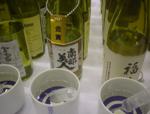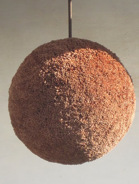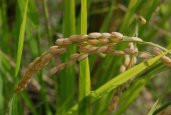|
|
|
Greetings to all readers,
Welcome to June, and in Japan, welcome to the rainy season, a full
ten days earlier than average. Other than the early start, it has not been too bad yet, a near-miss by Typhoon No. 2 notwithstanding.
The 2010-2011 brewing season has finally wound up, with all the tools washed, dried and put away until the fall. But the repercussions of what has transpired this year will live on forever and affect things for a long time to come.
Also, the next Sake Professional Course NYC to be held at Astor Center in New York City July 31 to August 2 is "filling up nicely," which is my ligh-hearted way of suggesting interested parties should act soon-ish to get a seat. If interested, please contact me soon.
Enjoy the newsletter!
Warm regards,
John
 
|
2011 National New Sake Appraisal Report
In a year of adversity and challenge
The 99th running of the National New Sake Appraisal, or “Zenkoku Shinshu Kampyoukai,” was held this past month. The results were announced on the morning of May 20, and a tasting for the industry was held May 25 in Hiroshima. As I do every year, I schlepped down there to do as much damage as possible in tasting the 875 entries - in six hours. Appraisal, or “Zenkoku Shinshu Kampyoukai,” was held this past month. The results were announced on the morning of May 20, and a tasting for the industry was held May 25 in Hiroshima. As I do every year, I schlepped down there to do as much damage as possible in tasting the 875 entries - in six hours.
I have written about this prestigious contest each year, with each article focusing on a different historical, technical or political facet of the event. The methods of selecting gold prize winners, and the rules of “the game” are covered in these articles as well. You can read those in the June or July editions of past years archived here and here.
The sake brewed for these contests is not normal for-the-market sake. It is specially brewed just for this tasting and needs to be totally fault free and extremely precise in its flavors, aromas and balances. I like to call it “daiginjo on steroids.” It’s intense. This is why it is worth tasting each year: one can see much about how the weather really affected things, and what aromas and styles are developing behind the scenes.
So, how was it this year? Well, first of all, the lead-up was ominous. It was a dreadfully hot summer, which makes it really tough to get any flavor out of the rice. Expectations were low on the part of many industry experts. On top of that were the natural disasters that have hit Japan since March 11. These of course dampened the mood, but affected the sake of many brewers - or at least should have. More on that later.
To be sure, much of the sake was tight, astringent and with little breadth. But really, it was not that bad at all. Much was finely rich, aromas did not seem as wild-n-wooly as in past years, and those that won gold medals were invariably of finely-wrought balance. For those interested, you can read the results (in Japanese) here.
There is always a new twist or catch each year, and this time was no exception. About a decade ago, sake made with rice other than Yamada Nishiki were judged separately. The reasoning there was that the contest is intended to foster technical developments. No one was using rice other than Yamada Nishiki as it is so dependable and predictable. That defeats the purpose, so to encourage brewers to experiment with other rice types, they were judged separately.
Well, this year, that separation was eliminated. In other words, the brewing industry has gotten good enough at making contest sake with non-Yamada Nishiki rice types so that the separate category is no longer needed. The fear of failure based on rice choice is no longer a big issues. So this year, all sake were judged in one big category, as they used to be.
As the tasting is really crowded, and as it is a case of “so many sake, so little time” with only six hours, a strategy is vital. For instance, if you line up at the popular regions first (the sake is separated into long tables by prefecture and region), you waste a lot of time waiting to get to the table, then waiting between each sake. But if you blow those off for later, you risk the allotted few bottles running dry, or worse yet, total fatigue and the inevitably following apathy.
Not surprisingly, considering both the earthquake-tsunami as well as the fact that the region has been kicking sake ass these past few years, the lines for the Tohoku tables were very long from the start. I availed myself of that fact and made a bee-line for Niigata.
Yet, the best laid plans of mice and sakeguys aft gang astray, and Tohoku stayed crowded. And by the time I did finally get there, at least half of the sake were gone. That hurt. But it was not surprising considering how well the region did this year. In fact, it was nothing short of miraculous.
Most obviously so was Miyagi. Together with Iwate, this is the place where most of the earthquake-tsunami damage occurred. But check this out: of twenty submissions from breweries in Miyagi, a full 17 took gold, and one more took the equivalent of a silver. That means only two submissions from this prefecture did not get a prize! (One of those was severely damaged in the disasters.) This, amidst all that took place.
One might be tempted to think the judges had pity on the region, but not a chance. It is all blind; all regions are mixed up and the judges have no idea what they are tasting in either of the two rounds.
As is the case almost every year, Niigata took the most golds with 22, but they had 79 submitted sake. It’s kind of like, if you throw enough kasu on the wall, some of it is going to stick. That is a 28% gold-rate, versus a whopping 85% from Miyagi. I was shocked that I had never analyzed the results like this before.
Not to diss Niigata! Perish the thought! Year in and year out, in contest sake and in regular market sake, they consistently produce some of the best sake in Japan there. And they deserve their high reputation. But the accomplishments of the brewers from Miyagi were outstanding to me this year, and made more poignant by the hardships endured.
Iwate Prefecture also did very well, with eight out of 15 winning a prize, six of which were gold. There, too, over half of the entries won a medal.
Another, tangential highlight was Kikumasamune from the Nada region of Hyogo. This company has long boycotted, or at least chosen not to participate, in the New Sake Competition. They are one of the most historically significant and stories brewing companies in the history of the industry, and one of the largest brewers as well. This year, after a decades-long hiatus, they submitted a sake - and won a gold! Not surprisingly, it was a stable, simple, Nada-esque sake that still managed enough ostentatious balance to do well.
Let’s all look forward to the 100th running of the event next year. Now that will be significant.
For those that are interested and that will be in Japan on June 15, you can taste all of the prize winners at the Sake Fair in Ikebukuro. See more details about that event below.
|
 Did You Know? Sake Kasu Did You Know? Sake Kasu
Sake kasu, usually just kasu in context, refers to the rice dregs,
or lees that remain after fermentation is complete. Recall that rice dissolves in the tank - its starches getting converted to sugar - while simultaneously the sugar is fermented to alcohol. So there is a mess of stuff that does not get converted or broken down enough, and is filtered out. (Since most sake later goes through charcoal filtering, the word “pressing” is commonly used to refer to this initial filtration.) That mess, compacted, is kasu.
The amount of kasu that remains after fermentation is a function of many things. How far did they allow the fermentation to go? In other words, did the brewer ferment to get maximum alcohol (less kasu) or a bit more quality (more kasu)? How tightly did they squeeze the kasu during pressing? Did they want every last drop (less - or at least lighter - kasu), or did they squeeze less hard in hopes of leaving some rougher flavors behind (more kasu)? So in some situations, more kasu indicates higher quality.
The weather during the rice growing season has a big effect as well. Hotter temperatures make for less soluble rice, which naturally leads to more kasu when it is all said and done. In this case, however, the sake would be less intense in flavor.
As is often the case with sake, several dynamics are in play at the same time, and it is difficult to say clearly what is better or worse. Suffice it to say that, given a set of boundary conditions (i.e. known factors, such as the weather during the growing season, the grade aimed for, the number of days fermenting and the temperature) for a given batch, a brewer can tell a LOT about a just-brewed sake by looking at the resulting kasu.
Also, see the December 2010 issue of this newsletter to see how sake kasu can be used with wonderful results in cooking.
So, the next someone asks you, "Did You Know?" you can answer, "Why, yes, I did know." |
 Sake Basics Sake Basics
Rice and Sake Flavors Last mon th, we looked at how yeast is what is behind the myriad of fruity aromas that can be coaxed out of the rice and into your sake. This would likely lead us to suspect that rice would contribute to flavor. And that suspicion would be correct. th, we looked at how yeast is what is behind the myriad of fruity aromas that can be coaxed out of the rice and into your sake. This would likely lead us to suspect that rice would contribute to flavor. And that suspicion would be correct.
However, while rice does lead more than anything else to flavor, there are a dozen other things that affect flavor too. The intent of the brewer, the way the koji mold is propagated, ambient temperature and much, much more.
And of the hundred-odd sake rice strains out there, many do have very identifiable characteristics that one can learn to taste with time. Yamada Nishiki is rich and full, Omachi is more astringent, Akita Sake Komachi and Aiyama both lead to a characteristic heavy-berry laced sake.
However, the connection between rice and the flavor of a sake is not nearly as tight as the connection between grapes and the flavor of a wine. Why not? Because of all the manhandling of the raw materials that go into sake production. |
 Announcements and Events Announcements and Events
Sake Professional Course in New York City

July 31 ~ August 2, 2011
"No sake stone remains left unturned."
The next stateside running of the Sake Professional Course will be held at Astor Center in New York City on Sunday, July 31 through Tuesday, August 2, 2011. The course will run basically 9 to 5 all three days, and will conclude with certification testing for the Certified Sake Specialist, recognized by the Sake Education Council. For more information go here . Feel free to ask me any questions about the course, or make a reservation with an email to info@sake-world.com.
2011 "Sake Fair" in Tokyo
Wednesdsay, June 15
On Wednesday, June 15, the sake industry will hold the 3rd annual
Sake Fair on the 4th floor of the World Import Building in Sunshine City, in Ikebukuro in Tokyo. There are two things happening more or less simultaneously on this day.
One is a public tasting of the National New Sake award winners. There are two sessions, 10am to 1pm, and 4pm to 8pm.
The other event, running from 11am to 8pm, is the All Japan Sake March, a large scale tasting with over 200 brewers present, and tasting booths from every sake-brewing prefecture in the country. Not only can you taste, but you can buy. It really is a wonderful opportunity to taste a huge range of sake from all over the country.
The seriousness of the tasting in the first event mentioned is countered by the light-heartedness of the second. Both are worth checking out, so my advice is write off the day (and perhaps the next one as well) and check it all out thoroughly. Tickets are 3000 yen in advance, and 3500 at the door, and will get you into both events. (You also get a take-home smile o-choko!) Not to be missed if you are anywhere close.
A bit more information is available here, including how to purchase tickets in advance.
Sake Education Council Website is Live!
Please take a moment to check out the website for the Sake Education Council, the organization behind the Certified Sake Professional and Advanced Sake Professional certifications. We plan to grow steadily, strongly and continually, and we will need the support of all those that love sake to do so. Follow us through the "usual suspects" of social media.
Sake Homebrewer's Online Store
Please be sure to check out Homebrewsake.com for supplies, information and a forum, including lots of supporting information on everything from recipes to history. I have been meaning to mention this site and the gentleman behind it, Will Auld, but have repeatedly forgotten in past newsletters. The site is replete with instruction, augmented with videos, schedules, and more. If you are even remotely interested check this site out right away.
Don't forget the archives!
Older editions of this newsletter are archived here.
Really old editions are archived here.
|
 Sake Education Central Sake Education CentralThe Sake Dictionary App for the iPhone and iPod
Newly improved, now with audio, and drastically reduced in price to $0.99!
There you are, perusing a menu, or standing in front of a shelf of great sake, or perhaps reading a sake newsletter… and up pops one of those hairy, pesky sake terms in Japanese. You know you have heard it many times, but dammit, you just cannot remember what it means now…
No problem! Just whip out your iPhone or iPod and fire up your trusty old version of The Sake Dictionary. In a matter of seconds, you’ll be amongst the cognoscenti once again. But… if only you could pronounce it properly. Now that would really rock!
Done! Just tap on the term and you will hear a clear example of how to pronounce the term in Japanese. Repeat it a couple of times and the term is yours for eternity, to toss about and impress your mates.
What’s more, it’s less! Less than what it cost before, much less. Like less than one-seventh less. For a limited time only, the audio-enhanced version of The Sake Dictionary iPhone app is available for a mere $0.99.
The Sake Dictionary is a concise little package of all the terms you might ever come across when dealing with sake. Almost 200 of them - including sake grades, rice variety names, seasonal sake terms, special varieties, rare types, post-brewing processing words and the myriad terms used in sake production - many of which are not even familiar to the average Japanese person on the street - are listed up here with concise, useful and clear definitions and the written Japanese version as well. And now, with the new audio component, you can listen and learn just how to pronounce those terms properly.
Start to toss around Japanese sake terms like you were raised knowing them! Gain a level of familiarity hitherto unimaginable! Avoid frustrating paralysis when faced with a sake-related purchase!
Get your copy of The Sake Dictionary now and never be confused by sake terms - or how to pronounce them - again.
Get it here: http://itunes.com/apps/sakedictionary
(Note if you have already purchased it, this upgrade to the audio version is free. Just go to iTunes and get it!) |
Stay Subscribed!
Are you not getting this newsletter? I realize that is like asking that "those not present please raise your hand," but for future reference, should you spontaneously stop receiving this newsletter, please go here and sign up again. Should that not work, please go to www.sake-world.com.
Email newsletter services are very careful not to be considered spam enablers, but the problem is that often very valid email addresses come back bounced as invalid. It is an unavoidable problem. So if you or someone you know is not getting this, or stop(s) receiving it inexplicably, please do take a moment to double check that you are still subscribed.
Sincere apologies for the hassle, mixed with gratitude for reading this newsletter.
|
I hope you have found the above information helpful and entertaining. For more information about all things sake, please check out www.sake-world.com. Until next month, warm regards, and enjoy your sake. 
Questions and comments should be directed to John Gauntner, at this email address.
All material Copyright, John Gauntner & Sake World Inc.
Regards,
John Gauntner
Sake World, Inc
 . . 
|
|
